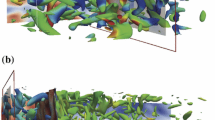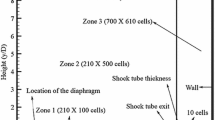Abstract
Three-dimensional unsteady Euler simulations are presented for the interaction of a streamwise vortex with an oblique shock of angle β = 23.3° at Mach 3 and 5. The flowfield features are analyzed for weak, moderate and strong interaction regimes. The details of the free recirculation zone at conditions of subsonic and supersonic flow on the vortex axis are considered. The vortex breakdown under conditions of a subsonic vortex core is characterized by a continuous growth and gradual degeneration of the region, unlike the supersonic core condition wherein a steady recirculation zone is achieved. The possibility of using a localized steady and pulsed periodic energy deposition on the vortex axis for stimulating the breakdown is demonstrated for various interaction regimes. It is shown that the formation of a subsonic wake downstream of an energy source lying on the vortex axis contributes to a more significant growth of the dimensions of the recirculation zone compared to the case when the vortex core remains supersonic. The possibility of achieving the effects similar to the steady case is demonstrated by the effect of a pulsed periodic energy source on the flow under consideration for corresponding equivalence parameters.
Similar content being viewed by others
References
Delery J. (1994). Aspects of vortex breakdown. Progr. Aerosp. Sci. 30: 1–59
Kalkhoran I.M. and Smart M.K. (2000). Aspects of shock wave-induced vortex breakdown. Progr. Aerosp. Sci. 36: 63–95
Mitchell A.M. and Delery J. (2001). Research into vortex breakdown control. Progr. Aerosp. Sci. 37: 358–418
Zatoloka V.V., Ivanyushkin A.K. and Nikolaev A.V. (1975). Interference of vortices with shocks in an inlet. The breakdown of vortices. Uchenie Zapiski TsAGI VI(2): 134–138
Figueirada Silva L.F., Sabel’nikov V. and Deschaies B. (1997). Stabilization of supersonic combustion by a free recirculating bubble: a numerical study. AIAA J. 35(11): 1782–1784
Chernyi, G.G.: The impact of electromagnetic energy addition to air near the flying body on its aerodynamics characteristics. In: Proceedings of the 2nd Weakly Ionized Gases Workshop, Norfolk, VA, 24–25 April 1998, pp. 1–31
Zheltovodov, A.A.: Development of studies on energy deposition for application to the problems of supersonic aerodynamics. Preprint 10–2002. Institute of Theoritical and Applied Mechanics, Russian Academy of Sciences, Siberian Branch, Novosibirsk, 43 pp (2002)
Knight, D., Kuchinskiy, V., Kuranov, A., Sheikin E.: Survey of aerodynamic flow control at high speed by energy deposition AIAA Paper 2003–0525 (2003)
Fomin V.M., Tretyakov P.K. and Taran J.-P. (2004). Flow control using various plasma and aerodynamic approaches (short review). Aerosp. Sci. Technol. 8: 411–421
Bityurin, V.A. (ed.): In: Proceedings of the 15th International Conference on MHD Energy Conversion and 6th International Workshop on Magnetoplasma Aerodynamics, vol. 1, 2. IVTAN, Moscow (2005)
Zheltovodov, A.A., Pimonov, E.A.: Streamwise vortex/shock wave interaction in energy deposition conditions. In: Proceedings of International Conference on the Methods of Aerophysical Research, Novosibirsk, Russia, Pt. II, 28 June–3 July 2004, pp. 237–245 (2004)
Zheltovodov, A.A., Pimonov, E.A., Knight, D.D.: Vortex breakdown control by energy deposition in high speed flows. In: Bityurin, V.A. (eds.) Proceedings of the 15th Intrenational Conference on MHD Energy Conversion and 6th International Workshop on Magnetoplasma Aerodynamics. vol. 2, IVTAN, Moscow, pp. 503–513 (2005)
Zheltovodov, A.A., Pimonov, E.A., Knight, D.D.: Supersonic vortex breakdown control by energy deposition. AIAA Paper 2005–1048 (2005)
Zheltovodov, A.A., Pimonov, E.A., Knight, D.D.: Vortex breakdown simulation by the steady and periodic pulse energy deposition in a vicinity of shock wave. AIAA Paper 2006–0401 (2006)
Thomer, O., Krause, E., Schrőder, W., Meinke, M.: Computational study of normal and oblique shock-vortex interactions. In: Proceedings of European Congress on Computational Methods in Applied Sciences and Engineering ECCOMAS 2000, Barcelona, 11–14 September, 2000, pp. 1–20 (2000)
Thomer, O.: Interaction between longitudinal vortices and normal and oblique shocks. In: Abhandlungen aus dem Aerodynamischen Institut der Rhein-Westf. Technischen Hochschule Aachen, Proceedings of Institute of Aerodynamics, Aachen University, Herausgeber University vol. 34, pp. 102–122 (2003)
Rizzetta D.P. (1995). Numerical solution of oblique shock-wave/vortex interaction. AIAA J. 33: 1441–1446
Rizzetta D.P. (1996). Numerical investigation of supersonic wing-tip vortices. AIAA J. 34: 1203–1208
Nedungadi A. and Lewis M.J. (1996). Computational study of the flowfield associated with oblique shock/vortex interactions. AIAA. J. 34: 2545–2553
Zheltovodov A.A. and Pimonov E.A. (2005). Investigation of localized energy deposition effect on streamwise vortex interaction with an obliqe shock. Thermodyn Aeromech 12(4): 517–537
Einfeldt B. (1988). On Godunov-type Methods for gas dynamics. SIAM J. Numer. Anal. 25(2): 294–318
Yamamota S. and Daiguji H. (1993). Higher-order-accurate upwind schemes for solving the compressible Euler and Navier–Stokes equations. Comput. Fluids 22: 259–270
Zudov, V.N., Pimonov, E.A.: Streamwise vortex/shock wave interaction. J. Appl. Mech. Techn. Phys. 44(4), 10–21 (2003) (in Russian)
Georgievsky, P.Yu., Levin, V.A.: Supersonic flow over sharpen bodies in presence of an unsteady energy supply upstream. In: Proceedings of International Conference on the Methods of Aerophysical Research, Novosibirsk–Tomsk, Russia, Novosibirsk, Publ. House of SB RAS, Pt. III, 9–16 July 2000. pp. 45–50 (2000)
Smart M.K. and Kalkhoran I.M. (1995). Effect of shock strength on oblique shock-wave/vortex interaction. AIAA J. 33(11): 2137–2143
Smart M.K., Kalkhoran I.M. and Bentson J. (1995). Measurements of supersonic wing tip vorrtices. AIAA J. 33(5): 1761–1768
Borzov, V., Mikhailov, V., Rybka, I., Savishenko, N., Yuriev, A.: Experimental investigation of supersonic flow around an obstacle at energy deposition into the free stream. Inzhenerno-Phzicheskiy Zhurnal (J. Eng. Phys.), 66(5), 515–520 (1994) (in Russian)
Yakovlev, V.: Flow gasdynamic structure space-time scales in aerophysical experiment with pulsating laser thermal source. In: Proceedings of International Conference on the Methods of Aerophysical Research, Novosibirsk, Part. III, pp. 273–276 (1998)
Author information
Authors and Affiliations
Corresponding author
Additional information
Communicated by D. Zeitoun.
Rights and permissions
About this article
Cite this article
Zheltovodov, A.A., Pimonov, E.A. & Knight, D.D. Numerical modeling of vortex/shock wave interaction and its transformation by localized energy deposition. Shock Waves 17, 273–290 (2007). https://doi.org/10.1007/s00193-007-0111-0
Received:
Accepted:
Published:
Issue Date:
DOI: https://doi.org/10.1007/s00193-007-0111-0




